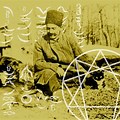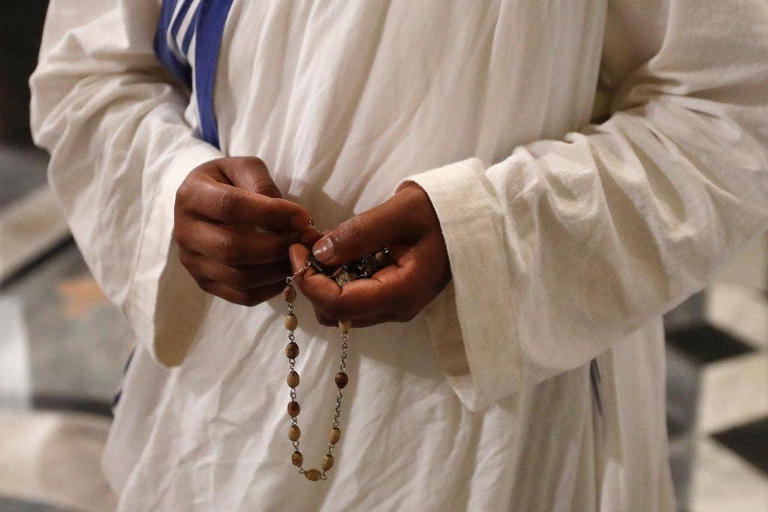Praying the rosary: Understanding the tradition that helps Catholics meditate on Jesus and Mother Mary
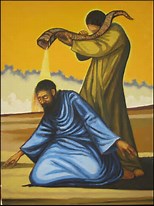









Praying the rosary: Understanding the tradition that helps Catholics meditate on Jesus and Mother Mary
Scores of Catholics and other practicing Christians pray the rosary all year long — and many bestow gifts of rosaries on family and friends for Christmas and other special occasions.
What is the rosary, exactly — and how do the faithful use its beads?
"The rosary is a combination of vocal prayer (the Our Fathers and Hail Marys) and of mental prayer — namely, reflection on important events in the life of Christ and His Mother," according to the website for the Rosary Center & Confraternity, a ministry of the Dominicans of the Province of the Holy Name of Jesus, in Portland, Oregon.
CAMPOS-DUFFY WARNS CHRISTIANITY UNDER ATTACK AFTER THE ATLANTIC CALLS THE ROSARY AN ‘EXTREMIST SYMBOL’
The founder of the Dominican Order, St. Dominic, helped to popularize the rosary in the 13th century, the website also notes.
"St. Dominic was distressed at his lack of success in his preaching in countering heresy, and in his desperation turned to the Mother of God for help," the Rosary Center notes.
MARY, MOTHER OF JESUS, WALKED THE PATH OF ALL STRUGGLING MOTHERS TODAY
This heresy "wrongly taught that all material things, including the human body itself, were fundamentally evil," according to Catholic.org.

"She appeared to him (according to the tradition) and told him to use her Psalter in conjunction with his preaching of the mysteries of our salvation, as an instrument in combating the great heresy of his day."
Since then, the rosary and rosary beads have been associated with the Dominican Order — and modern-day Dominican friars and sisters wear a set of rosary beads as part of their habits.
A set of rosary beads today includes 50 smaller beads divided into groups of 10 by a larger bead, along with a pendant consisting of a cross and five additional smaller beads, explains the website.
KIDS NEED PRAYERS! THESE FAITHFUL DEVOTIONS MAY HELP BLESS OUR CHILDREN
"When one refers to the rosary" — meaning the prayer itself, which is sometimes capitalized — "it is usually understood to mean five decades, or one fourth of the entire rosary," the site says.
The full rosary prayer involves 20 decades, each meditating on a different supernatural mystery associated with Jesus Christ's life, death, resurrection and earthly ministry.
Each decade of the rosary involves saying 10 Hail Mary prayers while meditating on one mystery, says the Rosary Center website.
Due to the length of the prayer, the faithful may opt to use rosary beads in order to track their place. A Hail Mary is prayed on each of the smaller beads, and an Our Father (also known as "The Lord's Prayer") is prayed on the larger.
The five "Joyful Mysteries" about Jesus' birth and early life are traditionally prayed on Mondays and Saturdays, while the five "Sorrowful Mysteries" concerning the crucifixion of Jesus are traditionally prayed on Tuesdays and Fridays.
SURFER BETHANY HAMILTON PUSHES PAST FEAR, TAKES ON NEW ADVENTURE
The five "Glorious Mysteries" regarding the resurrection of Christ are traditionally said on Wednesdays and Sundays — and the five "Luminous Mysteries" are prayed on Thursdays, according to the website.
Initially, the rosary prayer contained only 15 mysteries – the Joyful, Sorrowful and Glorious, Fr. Christopher M. Zelonis, pastor of Saints Peter and Paul Parish in Lehighton, Pennsylvania, told Fox News Digital.
"St. John Paul II’s letter ‘Rosarium Virginis Mariae’ in 2000 added the Mysteries of Light ('Luminous') to the 15 traditional mysteries," he said.
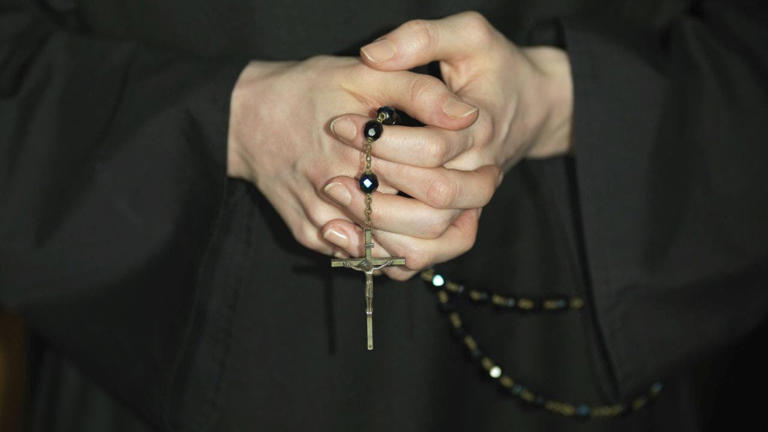
Praying the 15 original mysteries involved reciting 150 Hail Mary prayers, a number that corresponds to the number of psalms in the Book of Psalms.
"I always understood [the rosary] as a ‘home version’ of the 150-psalm Psalter that monks recited daily," said Zelonis.
NEW YORK MOM REVEALS BENEFITS OF MOVING HER KIDS TO CATHOLIC SCHOOL AMID COVID LOCDKOWNS
"The repeated Hail Mary serves as a backdrop for our personal meditation on the various aspects of Jesus’s life, seeking the unique perspective of his mother," he continued.
Zelonis said he is fond of using a scriptural rosary, which contains a passage to meditate on while praying. These can be found both printed and online, he said.
The meditative aspects of the rosary help immerse a person in prayer, said Zelonis. This is in comparison to the "pre-fab prayers" that are also part of church tradition.
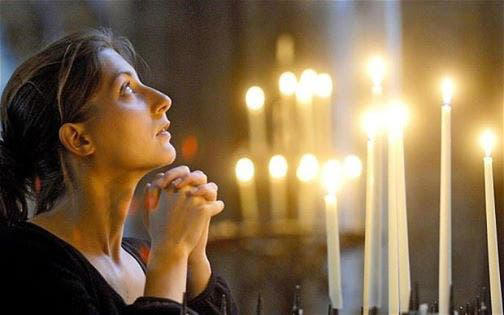
Pre-written prayers "are best supplemented by our own meditation, by which God can lend some depth to our understanding and love of Jesus and Mary," he said.
"We can put ourselves in the biblical scene or envision it as if watching a film."
Another addition to the traditional rosary prayer is the inclusion of the optional "Fatima prayer" after each decade. The "Fatima prayer" originates from a reported 1917 apparition of the Virgin Mary in Fatima, Portugal, according to the Rosary Center website.
October is known as the month of the rosary thanks in part to St. Pius V, a 16th-century pope, said Father William G. Most in his book, "Mary in Our Life."
AMERICANS RECITE BIBLE'S NEW TESTAMENT IN HISTORIC EVENT: ‘THE GREAT RECITAL’
"St. Pius V attributed the great defeat of the Turkish fleet on the first Sunday of October 1571, to the fact that at the same time the rosary confraternities at Rome and elsewhere were holding their processions," said Most.
Afterward, St. Pius V ordered a commemoration of the rosary to mark that day, and a feast day was later added to the church's calendar.
Today, October 7 is known as the "Feast of Our Lady of the Rosary" and is marked by prayers and public processions.

Christians of other denominations have found that praying the rosary has enriched their spiritual lives.
CLICK HERE TO SIGN UP FOR OUR LIFESTYLE NEWSLETTER
"I was raised in the Protestant tradition and still practice as such," Christian worshiper Peter Norris, 43, told Fox News Digital.
"I recently started praying the rosary."
Norris attends a nondenominational church in Rhode Island.
The rosary, said Norris, is "a wonderful meditation, a way to focus, to draw closer to Jesus."
"Calling in some help from Mary seems like a perfectly logical move," he also said.
"Perhaps the rosary can bring the world together."
Reference: Fox News:
What is Gurpurab? Sikhs celebrate Guru Nanak Jayanti
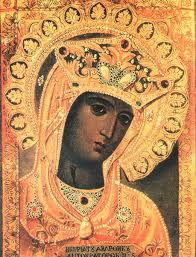










What is Gurpurab? Sikhs celebrate Guru Nanak Jayanti
The holy festival of Guru Nanak Jayanti, which is commonly referred to as Gurpurab, commemorates the birth of Guru Nanak Dev Ji, the first guru of Sikhism.
This year, it will celebrate Guru Nanak Dev Ji’s 553rd birthday and will place on Tuesday, November 8.
Every year, the occasion is marked on the full moon day of the Kartik month, which is also known as Kartik Purnima.
So who was Guru Nanak Dev Ji and how is Gurpurab celebrated?
Here’s everything you need to know.
Who was Guru Nanak Dev Ji?
Guru Nanak Dev Ji was a man of peace, who spent his life promoting equality and tolerance. He was born in 1469 in the village of Rai Bhoi di Talwandi. This is now called Nankana Sahib, near Lahore, which is now in Pakistan.
Numerous hymns written by Guru Nanak were compiled by Guru Arjan, into the sacred scripture of Sikhism, Adi Granth, when he travelled around India visiting holy places.
The verses of the Guru Granth Sahib, the central holy religious scripture of Sikhism, focus on the idea that there is only one creator of the universe. They also promote altruistic services to humanity.
How is Gurpurab celebrated?
Devotees around the world pray on this day, especially at the Golden Temple in Amritsar, north-western India.
The holy festival of Guru Nanak Jayanti, which is commonly referred to as Gurpurab, commemorates the birth of Guru Nanak Dev Ji, the first guru of Sikhism.
This year, it will celebrate Guru Nanak Dev Ji’s 553rd birthday and will place on Tuesday, November 8.
Every year, the occasion is marked on the full moon day of the Kartik month, which is also known as Kartik Purnima.
So who was Guru Nanak Dev Ji and how is Gurpurab celebrated?
During the procession, the revered Guru Granth Sahib is carried in a palanquin (a covered litter for one passenger, consisting of a large box carried on two horizontal poles by four or six bearers). Meanwhile, devotees chant hymns in unison and play traditional instruments.
Gurdwaras recite verses from the Guru Granth Sahib non-stop for 48 hours, starting with the Akhand Path chant.
The opening line of the revered Sri Guru Granth Sahib, which incorporates the composition and bani of all 10 Sikh Gurus, is claimed to be the first word in Sikhism. It’s titled Ik Onkar.
Following the festivities, volunteers host langars at gurudwaras, with many people participating in sewa (selfless service) while serving food to visitors.
What are the most common wishes and celebrations for the festival?
There are a number of wishes and celebrations for the festival, which include:
May the holiness and wisdom of Guru Nanak Ji illuminate your heart and mind. Happy Gurpurab!
May Guruji bless us in both delight and suffering. Wishing you a Happy Gurpurab because prayers are never in vain!
May Guru Nanak Dev Ji grant all of your wishes and bestow upon you his blessings forever!
Waheguru Ji ka khalsa, Waheguru ji ki fateh. Happy Guru Nanak Jayanti!
Reference: Evening Standard: Lowenna Waters
Vatican auditor says he uncovered a 'reign of terror' and blackmail from cardinals — now he's suing









Vatican auditor says he uncovered a 'reign of terror' and blackmail from cardinals — now he's suing
The Daily Beast reported that Milone, a former CEO of Deloitte in Italy, was hired to bring the Vatican bank back into "compliance with international norms on money laundering." Instead, he and his assistant say they were the ones who were falsely investigated, stolen from, harassed and ultimately shoved out, all for doing the work the Pope asked.
“We did the right thing, we never spied, we have been honest, we did what we had to do, but unfortunately what we had to do was very embarrassing,” Milone told Vaticanisti reporters. “I didn’t know that I would find cardinals putting money in their pocket, but I found it. And I told [the pope].”
Cardinal Angelo Becciu, who served as the Vatican's secretary of state, was the one who ensured that Milone was fired. It turns out he had his own scandal, accused of funneling $800,000 of the Pope's charity funds into paying for the false testimony against Australian Cardinal George Pell, who was accused of sex crimes.
"The appointment of Milone, under Pell’s recommendation, came at a time when the Vatican Bank was under so much scrutiny the European Central Bank prohibited the use of credit cards in Vatican City because the bank didn’t qualify for basic norms to protect the transactions," the report explained.
Milone thinks that he was fired to ensure the coverup of corruption with the Pope's charity funds as well as ongoing theft from the collections plate. At the same time, he said, departments in the Roman Curia had gold bricks and coins but refused to allow him access to even count it for the audit. A former auditor said that the cardinal kept about $250,000 in plastic shopping bags from the donations. That's the same cardinal who "accidentally" put that same amount into his personal account instead of the charity account it was supposed to be put into.
Milone said that when he told Pope Francis about the corruption, he was furious. The Pope went on to tell Milone to tell the cardinal that he was caught.
“This person became red. ‘But in my country, I can do what I like,’” Milone said the man replied. The cardinal then returned the funds.
Milone said that they planted fake evidence against him in addition to other kinds of harassment. His assistant characterized it as "a viper's nest" of "financial malfeasance, papal hypocrisy about transparency and a reign of terror by bug- and-blackmail-prone gendarmes."
“I was discovering things that somebody wanted to keep undercover,” Milone told reporters. “All these matters were reported to the pope. I wasn’t spying. I was doing my job.”
“I didn’t know that I would find cardinals putting money in their pocket, but I found it. And I told him,” he said of Pope Francis.
According to theNew York Times, Vatican prosecutors opened a fail on Milone for embezzlement "after a confidentiality seal was removed from the case."
Milone's fellow auditor, Ferruccio Panicco says that the Vatican even made his prostate cancer worse because they confiscated his medical records and then refused to release them. He said that it had cut his life short as a result.
Milone said that he hasn't yet named names, but he's willing to if the case goes to trial.
"Another antagonist for Mr. Milone was the commander of the Gendarmerie, Domenico Giani, who also was the pope’s bodyguard and subsequently resigned over leaks related to an investigation into apparent financial wrongdoing in the Vatican," the Times report said. "Mr. Milone said his office discovered that a refurbishing of Mr. Giani’s apartment ran to about 400,000 euros. The complaint claims that Mr. Giani’s portion of the expenses, about 170,000 euros, was provided by a money transfer from the Gendarmerie, not by him."
“Internal funds to pay personal expenses,” said Milone.
What the Vatican archives reveal about ‘Hitler’s Pope’
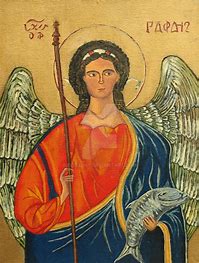








What the Vatican archives reveal about ‘Hitler’s Pope’
What is the purpose of the Catholic Church? Is it a spiritual institution dedicated to saving souls and offering moral leadership to the world? Or is it a multibillion-pound organisation anxious to protect its wealth and power? Or, if it is a bit of both, what is more important: morality or pragmatism?
A controversial figure: Pope Pius XII secretly negotiated with Hitler - Bettmann© Bettmann
These are the questions at the heart of David Kertzer’s magnificent The Pope at War, an examination of one of the most contentious religious figures of recent times, Eugenio Pacelli, who became Pope Pius XII in March 1939. Kertzer won the Pulitzer Prize in 2015 for The Pope and Mussolini, which focused on the Italian dictator’s dealings with Pacelli’s predecessor as Pope, Pius XI, and this new book is every bit as good.
Pius XII is controversial – in some quarters, notorious – because he never publicly condemned the extermination of the Jews during the Second World War. With access to the newly opened Vatican archives, and in calm, unhurried prose, Kertzer’s book ought to silence any future debate about him: based on the evidence presented here, there can no longer be any doubt – as a moral leader, Pius XII was a disaster.
Part of the reason was the Pope’s character – he was naturally timid – but Kertzer also reveals that there was a whiff of anti-Semitism around the Vatican during the war. In March 1943 – after the extermination of the Jews was known about – Monsignor Giuseppe Di Meglio wrote in a report entitled “Palestine and the Jews” that “most Jews are mainly dedicated to industry and, for the most part, commerce. This commerce remains quite profitable for them when they find themselves living among Christians. If, on the contrary, all and only the Jews come together, one has an enormous gathering… of swindlers, while lacking those to be swindled. Therefore, most Jews had no desire to migrate to Palestine.” The report was subsequently seen by the Pope, and there is no evidence that he was outraged by the anti-Semitic slurs within it.
Anti-Semitism in the Vatican wasn’t just confined to individual clerics. Francis D’Arcy Osborne, the British envoy to the Vatican, wrote in a 1938 dispatch to the British Foreign Secretary that Lenin had benefited from “the mental agility, the cynical adaptability and the amoral ingenuity of the Jew”.
But Kertzer also demonstrates Osborne’s subsequent outrage at the Holocaust, writing in December 1942 of “the unprecedented crime against humanity of Hitler’s campaign of extermination of the Jews”. Osborne was appalled at the Pope’s lack of protest at Nazi atrocities, saying in September 1942: “A policy of silence in regard to such offences… must necessarily involve a renunciation of moral leadership and a consequent atrophy of the influence and authority of the Vatican.”
In his Christmas address on December 24 1942, the Pope did make one reference to the “hundreds of thousands of people who, through no fault of their own and solely because of their nation or their race, have been condemned to death or progressive extinction”.
But because he didn’t mention the Jews by name, these words could be taken to refer to the actions of a number of different nations – the Pope had a well-known fear of communism, for example, so he could have been condemning Stalin’s crimes. Kertzer reveals that “Osborne subsequently wrote that the Pope seemed ‘pained and surprised’ that these words had not satisfied those who had been calling on him to speak out”.
Both Hitler and Mussolini were – nominally, at least – Catholics themselves. But the Pope never moved to excommunicate them, nor to threaten to excommunicate the Catholic Germans who took part in the killing of Jews. Part of the reason may have been that he was worried speaking out might mean Hitler would escalate his campaign against Catholicism. Many churches in Poland had already been closed and Catholic priests sent to concentration camps. Perhaps he feared that even the Vatican, the immensely wealthy heart of the church, was at risk.
However, as Kertzer points out, there were Catholic priests who did take a stand against the Nazis. Some, for instance, tried to help Jews by hiding them on church property. While the Pope did not prevent them doing this, he wasn’t exactly encouraging, either.

Kertzer could have mentioned, by contrast, Bishop von Galen, who gave a sermon in Münster in Germany in August 1941 denouncing a different Nazi atrocity: the killing of the severely disabled. Significantly, although Hitler was furious at von Galen, he did not act against him for fear of alienating the local German population.
We can’t be certain, of course, what Hitler would have done if the Pope had protested openly about the fate of the Jews. What we do know for sure is that, if Pius XII had spoken out, he would have rendered humanity a service that we would still be celebrating today. Instead, unlike the long list of martyred Catholic saints who endured hideous tortures in defence of their moral and spiritual beliefs, Pius XII chose to remain silent.
The Pope at War is a long book, but unlike many scholarly works it is readily accessible to the general reader. Kertzer is a gifted writer, and the chapters are short and punchy. He is also to be congratulated on avoiding polemic. It would have been easy, given the evidence, to have suffused the pages with moral outrage. But because he lays the facts bare and presents all sides of the argument, he lets readers come to their own conclusion. And that conclusion ought to be a devastating one: Pius XII’s prime concern during the war wasn’t offering moral leadership, but protecting the interests of the Catholic Church.
The material from the newly opened Vatican archives largely speaks for itself. For example, several months prior to the outbreak of the war, the Pope was secretly negotiating with Hitler a better accommodation between the Nazis and the Catholic Church. The Nazis’ intermediary was a German aristocrat called Prince Philipp von Hessen. At their first meeting in May 1939, Pius XII, who had spent time in Germany and was fond of the country, told von Hessen that “No one here is anti-German. We love Germany. We are pleased if Germany is great and powerful. And we do not oppose any particular form of government, if only the Catholics can live in accordance with their religion.”
These remarks, we must remember, were made just months after the Nazis had unleashed a torrent of violence against German Jews during Kristallnacht. And even after the Germans had invaded Poland in the autumn of 1939 and committed a series of new atrocities, the Pope ended another secret meeting with von Hessen by asking that his “warm greetings” be conveyed to the Führer. Ultimately, these secret negotiations came to nothing, but they are the background against which we should see the Pope’s public silence during the war about the Holocaust. What a tragedy, the reader might think after finishing this groundbreaking book, that the Pope did not “love” the Jews as much as he “loved Germany”.
The Pope at War: The Secret History of Pius XII, Mussolini, and Hitler by David I. Kertzer is published by Oxford University Press at £25. To order your copy for £19.99 call 0844 871 1514 or visit Telegraph Books
Reference: The TelegrapH: Laurence Rees
Articles-Latest
- Koran burning conviction sparks fury as blasphemy law 'returns to UK'
- Robert Francis Prevost - Pope Leo XIV
- Pope Francis' death follows recent health challenges. Here's what we know about how he died.
- Easter April 2025 - international Celebrations
- The Rule of the twelve psalms -Worthy is the Lamb
- Religion in Africa Before Christianity and Islam
- 6 The Origin of Yahweh
- Dumo Di Milano
- What Did the Crow Tribe Believe In: Discover The Beliefs!
- 7 Reasons Historic Christianity Rejects the Book of Enoch
- 8 Breathtaking Mountain Monasteries Around the World
- Ethiopian Bible is oldest and most complete on earth
- Muhammad Muhammad was a prophet and founder of Islam.
- World Day of the Poor – SVP Christmas Campaign 2024
- Pope Francis to open 5 sacred portals on Christmas Eve — for a ritual that’s never been done before
- The 144,000 in Revelation
- Over 73 dead bodies 'used for meditation', 600 crocs in a pond, found in two Thai temples
- Occultism: Western Occult Tradition
- What is a Mudra
- Blood Sacrifices: Ancient Rituals of Life and Death
Articles-Most Read
- Home
- Let There Be Light
- Plants that feel and Speak
- The Singing Forest
- The Singing Forest-2
- Introduction
- Meditation
- Using Essential Oils for Spiritual Connection
- Heaven Scent
- Plants that Feel and Speak-2
- Purification
- Making the Spiritual Connection
- Anointing
- Essential Oils: The unseen Energies
- The Sanctity of Plants
- The Aroma Of Worship - Introduction
- The Aroma Of Worship-Foreward
- Methods Of Use
- Spiritual Blending
- Handling and Storage



